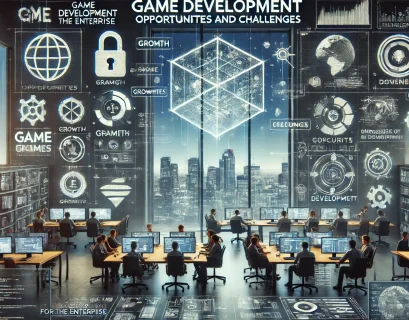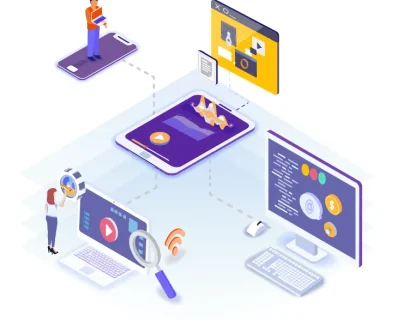Looking at the current trends projected and emerging across the digital marketing landscape 2024 is seen to be a milestone year. With Virtual Reality (VR) and /or Augmented Reality (AR) set to increase their dominance. The use of technology in Virtual and Augmented reality is revolutionizing how brands adapt to changes in consumer literacy level about technology. While making content more interactive to engage an audience. Such technologies allow brands to deliver engaging and immersive campaigns and blur the divisions between on and off the digital realm. As this very year 2024 is likely to witness a further advancement in use of these innovations, the companies have to start adapting their marketing concepts. A website design company can play a crucial role in integrating VR and AR into online platforms. This ensures a seamless and engaging user experience that aligns with these new digital marketing trends.
Augmented reality and virtual reality is no longer restricted to being just a gaming concept or entertainment tool. They are already becoming toolkits in several business sectors such as retail and commercial real estate, travel and education. These technologies are being used to customize the adverts, manage consumer relations and bring out the best out of the customers. It has already begun to transform digital marketing and unlock ways for brands to talk to consumers that previously did not exist. Companies offering digital marketing services in Dubai are increasingly incorporating VR and AR into their strategies. This helps brands deliver cutting-edge experiences and stand out in the competitive market.
- Immersive brand experiences
- Enhanced personalization
- Revolutionizing ecommerce
- Enhanced storytelling and brand narratives
- Event marketing and virtual spaces
- Gamification and interactive campaigns
- Driving innovation in customer support
Immersive Brand Experiences:
Both Virtual Reality and Augmented Reality enable brands to give customers realistic experiences through touch point impressions to the deepest senses. Static advertisements can be replaced by placing the viewers directly into an interactive showroom. It will work by helping them ‘dress,’ or showing them different places through AR environments. This conversion from simple audience perspectives to expansive involvement in marketing content raises familiarities and evolves passions.
Enhanced Personalization:
Consumers have always strived for personalized experience in marketing which digital marketers have been trying to achieve for a long time now. VR and AR bring this to the next level. For instance, a fashion retail firm can employ this technology to make the virtual fittings in an e retail shop. Basing it on the customer’s size and preferred styles. It raises customer loyalty and interactivity because customers use products that are tailored to their needs and expectations in the process.
Revolutionizing Ecommerce:
Business-to-Consumer is one of the industries that will be most impacted by the integration of VR and AR. I shopping enthusiasts can walk through virtual stores, handle the products as in actual physical stores, and make a purchase decision online without physically moving from home. This does away with one of the most significant factors that affect online sales – people cannot touch products physically hence improving trust for the products hence the sales.
Enhanced Storytelling And Brand Narratives:
Several brands are leveraging the current consumer truth that VR and AR are powerful tools for storytelling compared to media marketing. It sounds like a great experience to even take a virtual tour and or even become an active participant in the making of a brand. Such a form of storytelling involves the audience making the marketing message more effective and memorable within the brand’s domain. By 2024, this level of storytelling will be the defining factor of which brands will rise to the top.
Event Marketing And Virtual Spaces:
Some popular virtual events that use Advanced Reality have brands experimenting with VR and AR to offer excellent event experience. Today every company is able to have an online product launch, conference or even a fashion show. People from all over the world can be part of it in real time. AR enables the user to also expand their capacities for engaging with the event itself. This will be done by greeting and shaking with the holograms mixed into the physical space. Also, by walking around and visiting the event spaces, and answering questions in the live Q&A sessions. This will bring more possibilities to the virtual events and make it possible to reach out to a global audience.
Gamification And Interactive Campaigns:
Ever since, the use of game-elements has always been a means to attract customers, with AR and VR this just gets even more interesting. Some of what brands can do is develop engagement campaigns. Where users get some sort of incentive by accomplishing specific features or by partaking in AR tag hunt games. Such interactive games improve consumption by consumers, help brand owners nurture their loyalty, and go viral on social networks. Thus engaging consumers in the process of marketing.
It is apparent that as the world progresses deeper into 2024, technologies such as VR and AR will reshape the face of digital marketing. They are transforming consumer-brand engagement through immediate experiences, customization, and interactivity. The marketers who use these technologies can find a way to influence the audiences at a deeper level. And nurture the emotional bonds that define today’s consumerism. Thus achieving better and more impactful results. With these tools, the opportunities for advancement in the marketing field are as vast as the sky. Meaning that the future for digital marketing will only continue to evolve in exciting ways.




















